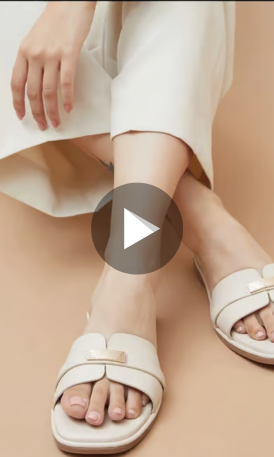It’s not just footwear—it’s a fashion identity.
Sandal selection reveals more about personal style than perhaps any other footwear choice. The divide between ankle strap devotees and slide enthusiasts represents two fundamentally different approaches to warm-weather dressing—one embracing strategic security, the other celebrating effortless liberation. The perfect summer sandal wardrobe incorporates both philosophies for maximum versatility.
Ankle Straps: Architectural Security

Ankle-strap sandals deliver distinctive benefits beyond their obvious visual appeal. The defined band encircling the ankle introduces vertical lines that elongate the leg while creating a visual anchor point that balances proportions, particularly valuable when paired with voluminous summer fabrics.
The ankle strap’s greatest strength lies in its adaptability across formality spectrums. The same fundamental structure works magnificently for garden weddings (delicate leather straps, botanical embellishments) and beachside dinners (rope detailing, natural textures). The key distinction? The structured band operates as both a functional element and a design opportunity, with width, closure mechanism, and placement dramatically altering the sandal’s character.
Slide Sandals: Effortless Sophistication

Slide sandals embody the minimalist ethos where less delivers significantly more. Their streamlined construction eliminates visual clutter while allowing the foot’s natural contours and silhouette to remain visible, a surprisingly powerful design element. The uninterrupted line creates elongation effects that balance summer’s more relaxed proportions, particularly valuable with cropped hemlines and voluminous silhouettes.
Their slip-on construction introduces remarkable versatility across contexts, from poolside moments to urban exploration. The slide’s aesthetic impact relies heavily on material selection and strap construction; substantial leather bands create architectural presence, while delicate straps introduce unexpected delicacy to this unfussy silhouette.
Now for the big question—Which one suits you best?
The Body Type Consideration
Ankle proportions significantly influence sandal selection. Narrower ankles benefit from the definition that straps provide, creating visual structure and balanced proportions. Meanwhile, those with more substantial ankles often find slides offer more flattering lines by maintaining visual continuity without horizontal interruptions.
Foot width similarly impacts ideal sandal architecture. Narrower feet risk appearing lost in substantial slide designs, while wider feet gain proportion balance from their horizontal expanse. The ankle strap creates definition regardless of foot width, though strap placement (higher versus directly at the ankle bone) dramatically alters visual impact.
The Style Personality Factor
Ankle strap enthusiasts typically prioritise intentional dressing, appreciating how strategic structure creates refined silhouettes. Their wardrobes often feature architectural elements, defined waistlines, and considered proportions. The ankle strap sandal complements this thoughtful approach, extending intentional styling to footwear selection.
Slide devotees embrace effortlessness as their style foundation, valuing the poetry of movement and unrestrained energy. Their aesthetic typically incorporates relaxed silhouettes, fluid fabrics, and simplified colour stories. The slide sandal extends this philosophy to the ground, maintaining the unbothered sophistication that defines their style.
The Hybrid Revolution
Contemporary footwear design increasingly blurs these categorical boundaries. The ankle-wrap slide combines the slip-on construction of slides with decorative ankle straps that provide visual interest without structural constraint. Meanwhile, the minimal ankle strap introduces barely-there security with almost slide-like simplicity.
These hybrid options deliver versatility across styling contexts, offering precise ankle definition without overwhelming visual weight or slide simplicity with added security for varied terrain. The result? Maximum adaptability while maintaining distinctive structural elements that define each style’s unique character.



